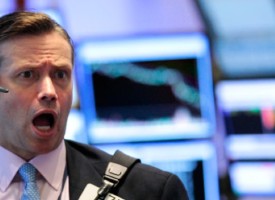Today the top trends forecaster in the world, Gerald Celente, issued one of his most important updates of 2019.
Same Post-Recession Growth Rate For A Decade
November 6 (King World News) – Gerald Celente : “The U.S. Federal Reserve lowered interest rates for the third time and accelerated monetary injections into the overnight repo markets. Additionally, they are buying $60 billion per month in Treasury bills to ensure “ample reserves” in the banking system.
Immediately following the Fed’s rate-cut announcement were reports of sunny U.S. employment numbers, higher than expected corporate earnings, and the on-and-off again U.S./China trade deal.
On Tuesday, the U.S. Commerce Department said the GPD grew 1.9 percent in the third quarter, down from 2.0 percent in the second quarter but beating analyst predictions of 1.6 percent.
While the markets cheered the numbers, however, yearly GDP growth is expected to increase only around 2.1 percent.
This is the same post-Great Recession growth rate for the past ten years – not the 3-percent-plus promised by the Trump administration as a result of its aggressive 2017 corporate tax cuts, which were lowered from 35 percent to 21 percent.
Following the Fed’s overnight benchmark lending rate cut, lowered by one-quarter of a percentage point to a range of 1.5 percent to 1.75 percent, Chairman Powell intimated that another cut would be unlikely and Wall Street agreed.

TREND FORECAST:
While we concur with the future market estimate that the odds of the Fed lowering rates following their 11 December meeting are negligible (8.1 percent probability of another rate cut, CME FedWatch Tool), we forecast that U.S. rates will be zero to negative by the end of 2020.
PUBLISHER’S NOTE:
The Swiss National bank’s interest rate is at negative 0.75 percent.
While the lowest among the Group of Ten (G-10) economies, its head bankster, Thomas Jordan, claims this “unconventional instrument” with “side effects,” i.e., pension funds worsening and bond yields collapsing, will remain policy “for some time to come.”
It is long noted that negative/low rates hurt banks’ profitability and lead to significant underperformance relative to global peers.
Indeed, Deutsche Bank, Germany’s largest bank, reported its fixed income business dropped 13 percent, which contrasted with the average 11 percent gain compared to its Wall Street rivals. By year’s end, the banks’ cumulative losses since 2014 will exceed €14 billion.
Deutsche Bank’s share price has fallen by 80 percent over the past decade, and it slipped from being the second largest bank in the world by assets to the 17th.
Deutsche Bank also informed 18,000 of its employees that they will be losing their jobs. Considering its size, income, and liabilities, should Deutsche Bank collapse, it will be a “Lehman Brothers 2008” moment.
Lehman’s, which in 2007 ranked as the 47th largest bank by assets in the world, was the largest bankruptcy in U.S. history. Its 2008 bust contributed to the erosion of $10 trillion in market capitalization from global equity markets… the largest monthly decline on record, which set off the Panic of ’08…
ALERT:
Mining legend Ross Beaty (Chairman Pan American Silver) is investing in a company very few people know about. To find out which company CLICK HERE OR ON THE IMAGE BELOW.
 Sponsored
Sponsored
Back to the Numbers
On Friday, the Labor Department reported that 128,000 jobs were added in October and adjustments to September’s numbers added another 95,000.
The report was higher than expected, despite General Motors shaving 50,000 workers from the numbers who were on strike, plus an additional 20,000 temp workers who were laid off.
The “official” unemployment rate reported in the press ticked up to 3.6 percent from 3.5 percent in September.
Also called the “standard” rate, the official rate only counts people in the labor market who have looked for a job in the past four weeks. Once they stop looking, they are no longer counted.
The “real” unemployment rate includes the “underemployed” – part-timers looking for full employment, sometimes working two jobs; those who are overly skilled for the jobs they have landed; and those with full-time jobs who still live below the poverty line.
The real October unemployment rate of 7.0 percent also includes the “discouraged” – the unemployed who have looked within the last year.

TRENDPOST:
Most of the jobs created in America the past month were in low-paying health care, social services, and hospitality sectors. They are the 40 percent of adults who won’t be able to cover a $400 emergency expense.
With wage growth essentially stagnant, some 51 percent of working Americans are earning less than $30,000 a year and 40 percent are earning under $20,000 per year.
Low-paying temporary employment will increase during the holiday season.
To ramp up, many retailers, warehouses, and logistics companies plan to use “collaborative” robots, also called “cobots,” from companies such as Locus Robotics Corp.
The industry claims that the “tight labor market” needs robots – outfitted with cameras, lasers, and sensors – to navigate warehouse aisles and find the coordinates of particular items on shelves.
PUBLISHER’S NOTE:
Robots and artificial intelligence will continue to erode menial workforce jobs, pushing up unemployment rates across the globe.
As we have noted, housing prices have sharply risen while median U.S. household income is at 1999 levels.
Therefore, despite lower U.S. interest and mortgage rates, average Americans still can’t afford a home in 70 percent of the country.
In major coastal cities such as San Francisco, Seattle, and Boston, according to the real estate site Zillow, the median price of a home listed for sale is well over $500,000.
And, with a slowdown in building starter homes, the average price for a home in these cities, if you can find one, is around $300,000.
A few percentage point drop in a mortgage makes little difference, thus shutting out first-time home buyers, who don’t have the cash for a down payment…
BONUS INTERVIEW:
To listen to Doug Casey’s just-released KWN interview discussing his prediction of financial and economic chaos and a panic into gold CLICK HERE OR BELOW:
Lower Wages, Higher Debt
Due to stagnant and declining wages, personal loans are no longer a last resort for indebted Americans as they watch their bills pile up.
Experian, a credit analysis firm, has reported that in the second quarter of 2019, personal loans maxed $305 billion, a 12 percent increase from the previous year.
Personal loan balances average $16,259. Balances of $30,000 or higher have jumped 15 percent compared to only five years ago, and loan balances of $20,000 to $25,000 have increased 10 percent.
These numbers are even higher than credit card debt, typically the forerunner in American debt balances.
The lenders? Online loan installment companies that charge triple-digit interest rates, like payday lenders, except they have longer payoff times. They are also conveniently unencumbered by the modest restrictions regulating payday lenders.
Financial technology firms, commonly known as “fintechs,” offer unsecured personal loans, doubling their market share of personal loans from 22.4 percent in 2015 to 49.4 percent in 2019.
PUBLISHERS NOTE:
Among the already financially strapped, the bad debt situation – student loans, car loans, credit card debt, mortgages – will only get worse as unemployment rates rises.
What Does Ray Dalio Say To Buy?
READ THIS NEXT! Art Cashin Weighs In On Ray Dalio Stating That “The World Has Gone Mad,” Plus What In The World Happened? CLICK HERE TO READ.
***KWN has released the powerful audio interview with Bill Fleckenstein where he discusses the gold market at length, what to watch in the stock market and much more CLICK HERE OR ON THE IMAGE BELOW.
© 2019 by King World News®. All Rights Reserved. This material may not be published, broadcast, rewritten, or redistributed. However, linking directly to the articles is permitted and encouraged









